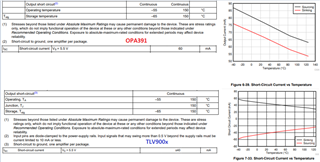Hi team,
What does "Output short circuit" absmax mean and what does "continuous" capability mean?
OPA391 shows its absmax output short circuit as "min: continuous" and "max: continuous". On the other hand, TLV900x says absmax output short circuit as min: continuous and max: no specification.
How should we use these difference and what is TLV900x bottle neck compared with OPA391 in aspect of output short circuit condition?
In addition, Both of OPA391 and TLV900x have "short circuit current" typical value at VS=5.5V shown in "Electrical Characteristics".
Do you have test circuit diagram? Which circuit did you measure this current value?
Regards,
Ochi



